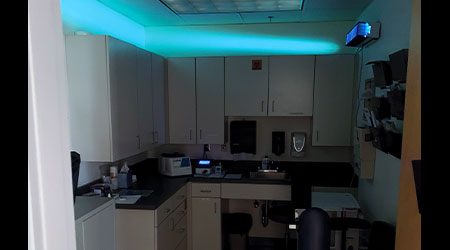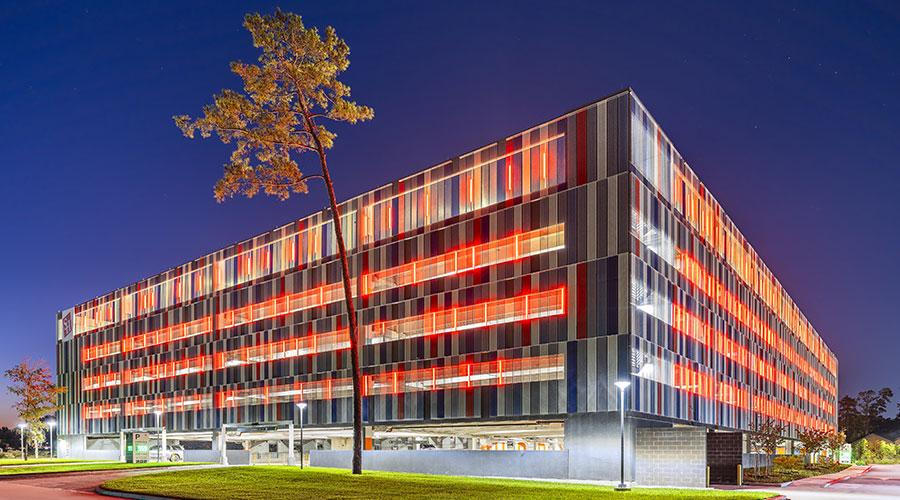COVID Accelerates Adoption of UV at Two Facilities
Facility managers turn to ultraviolet light for coil cleaning and upper air disinfection.
By Dave Lubach, managing editor
When the COVID-19 pandemic engulfed the nation in March 2020, facility managers were left scrambling for ways to keep their buildings safe.
Managers and occupants of institutional and commercial facilities were collecting information about the virus on the internet and from television, forming their own opinions on how deadly and how highly transmissible COVID-19 was. Managers were learning mostly on the fly like everyone else.
The most important question for FMs to answer was: Would occupants feel safe when returning to the workplace?
“People were doing their homework, and we had to be the subject matter experts before they told us, ‘Hey, why don’t you try this?’,” says Tai Davis, Director of Facilities Operations at Fayetteville State University in North Carolina. “We were looking at all of our options as to what’s out there, and what could we do? We were definitely concerned with indoor air quality before COVID, but (the pandemic) took it to a whole other level.”
Early on in the pandemic, Davis, like many of his counterparts across the country, turned to ultraviolet light (UV) technology to help with the disinfection process in buildings and keep them safe when occupants returned.
Davis and Fayetteville were not alone in the use of UV. All across the U.S., facilities were exploring the technology in the fight against COVID-19.
Small area, big impact
Fayetteville State wasn’t looking to equip its entire campus or a building with UV lighting to combat the spread of the coronavirus. But its planned application was certainly an important one.
The university, part of the University of North Carolina system and a historically black public regional school, installed UV lighting in its student health infirmary, the Spaulding Building. The focus area was only about 1,000 square feet, but it was important that the air was disinfected for the patients and the medical staff.
Like many facility managers at universities across the country, when the pandemic began, the race was on for Davis to learn more about how to combat the virus.
“It was something new, something we’d never seen before,” Davis says. “We were just trying to identify ways to protect not only the students, but the staff who had to come back in and work. We were looking at all types of options and things we could implement to ensure the safety and indoor air quality of our teams.”
The search for a solution led Davis to UV Resources to aid in airborne infection mitigation. The fixtures come in three sizes, the GLO 310, GLO 225, and GLO 150, with the number reflecting the square footage a fixture is designed to treat. Fayetteville State installed five 225 fixtures to cover observation rooms, one of which was testing students for COVID, and a waiting room.
Davis says the fixtures are easy to install and are mounted on the wall near the ceiling, with a recommended height of at least 7.5 feet to assure maximum impact. Installation concerns were also helped by the fact that the fixtures only require standard electrical outlets to operate.
Time was of the essence during the early stages of the pandemic, and Davis found that the ease of installation was an appealing aspect.
“The lead time wasn’t very long,” he says. “A few weeks or so. As soon as we got them into our warehouse we were able to install them the next day. When we were pitched the idea, we thought, ‘Hey, let’s try it.’ We didn’t have a whole lot of information (at the start of the pandemic) on whether it would work and honestly, we didn’t have a whole lot of time to really think about all those things. If something’s going to help, it’s not going to hurt to try it.”
The fixtures were a good decision.
“Our nurses and students there, they loved them,” Davis says. “It gave them a sense of a safer environment, because they were testing for COVID in those spaces.”
IAQ and maintenance benefits
Crescent Real Estate manages two large office buildings in the Dallas-Fort Worth area. One of the buildings is Greenhill, a 280,000 square-foot-building, and the other is 511 East John Carpenter, a 164,000 square-foot-building.
Josh Hartsell, a chief engineer for Crescent, has been focused on improving the indoor air quality (IAQ) in the two mammoth office buildings well before the pandemic took hold. The pandemic put him on a faster track to address the issue.
“I’ve always wanted to do it,” he says. “I probably wouldn’t have foreseen the pandemic response component of that from a design standpoint. As far as COVID being a push to decision-making, I think yes, it definitely helped me get these projects approved.”
In addition to improving the air quality inside his commercial buildings, Hartsell also was seeking to reduce maintenance costs. He turned to a disinfection system that was installed in the building’s air ducts. The ASHRAE-validated system was important, Hartsell says, in order to convince businesses interested in leasing space that the buildings were safe.
“That was the biggest deciding factor,” he says. “You’d like to see at least some sort of certified standard, and that’s where UV has a big advantage for people in our industry.”
Crescent Real Estate installed two separate UV light systems. The first system was devoted to coil cleaning to maintain the heat exchange efficiency system, and the other was geared toward infection control. Each is a 15-watt system that can be run separately to maximize bulb life. But they are designed to operate concurrently when a flu or another pandemic occurs, to double the germicidal power to inactivate airborne pathogens when they pass through HVAC units.
“The 30 watts give us a 90 to 95 percent single pass kill flow rate,” Hartsell says. “We’ve got two maintenance systems we can use when we don’t need to clean the air strictly for airborne pathogens. That cuts us down on energy and prolongs bulb life. You can also tie the systems into your building automation system, so it all happens automatically and it tracks it for you and alerts you to one off, or something to that nature.”
Hartsell says his company has saved about $8,000 on maintenance costs, with most of the savings coming from the less frequent need to clean coils.
“Before we installed the UV, the coils looked clean, but they didn’t look new,” he says. “Now they look brand new.”
Beyond the pandemic
The pandemic caught the attention of building owners and management teams about the importance of IAQ.
For engineers like Hartsell, the pandemic provided a golden opportunity to push his bosses on making increased investments to improve IAQ at their other facilities. Hartsell has already taken similar measures in his company’s other buildings to show that upgrades such as these will improve the office experience well beyond whenever the pandemic fears are pushed aside.
“We don’t want to spend a bunch of money on something that might not be used in two years, but put the spin on it to where you can use it, and that you’ll have the ability to respond to an airborne pathogen,” he says. “Looking at it from a benefit outside of COVID, you can boast that the air is being cleaned better than 75 percent of other buildings you can lease space from. Building a project like that across the board helps. It’s who you’re presenting it to and if they understand it.”
Davis is looking to expand the use of UV on campus, considering using the technology in areas such as lecture halls and dorm rooms, or other areas where students are gathered in tight spaces. He also emphasizes that managers should focus on benefits beyond the pandemic to justify the expenses associated with installing new fixtures.
“The fixtures help ensure the safety of our campus community,” he says. “Give leaders that information as well as some of the bullet points of what they do. We were able to keep (school) going through the fall semester when others couldn’t.”
Dave Lubach is the managing editor for the facility market team. He has six years of experience writing for the facility management industry.
Related Topics:












